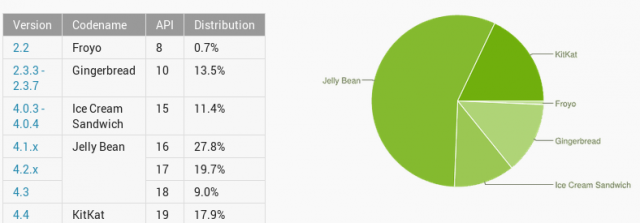
A new month, a new set of platform distribution numbers. It’s all good news as the rollout of Android 4.4 keeps increasing, with just a just over 4% increase in market share.
For the rest of the platforms the numbers are still decent. Froyo continues to drop, down another 0.1%, continuing its inexorable march towards obsolesence. Gingerbread too has dropped, at seemingly a faster rate shedding 1.4% of their market share in a month. Ice Cream Sandwich use also dropped, down to 11.4% of the overall pie. Jelly Bean too saw a decrease in usage, going from an overall 58.4% of the market down to 56.5% across its three version number(4.1-4.3) spread.
The comparsions to last month for your consideration :
| Android Version | May | June |
| Android 2.2 (Froyo) | 0.8% | 0.7% |
| Android 2.3.3 – 2.3.7 (Gingerbread) | 14.9% | 13.5% |
| Android 4.0.3 – 4.0.4 (Ice Cream Sandwich) | 12.3% | 11.4% |
| Android 4.1.x (JellyBean) | 29.0% | 27.8% |
| Android 4.2.x (JellyBean) | 19.1% | 19.7% |
| Android 4.3 (JellyBean) | 10.3% | 9.0% |
| Android 4.4 (KitKat) | 13.6% | 17.9% |
Source: Android Developer Dashboard.





No mention of devices running Lamington.
So, by these numbers, about 27% of devices (???) are Android Wear compatible! 100% would be better but considering the long tail of device ownership, this is pretty handy!
True, although I’d guess that those most likely to pay $250+ for a first-generation Wear device are also more likely to have a modern, up-to-date phone.
Unless the Moto 360 is an instant hit in the mainstream (not just tech circles), it will probably be a little while before Wear becomes mass-market simply due to it being a ‘supporting’ or secondary device rather than viewed as something ‘essential’. By then, it’s likely the vast majority of Android phones will be ready,
No Kit Kat on my mega 6.3 i9205 or note 8.0 :-/